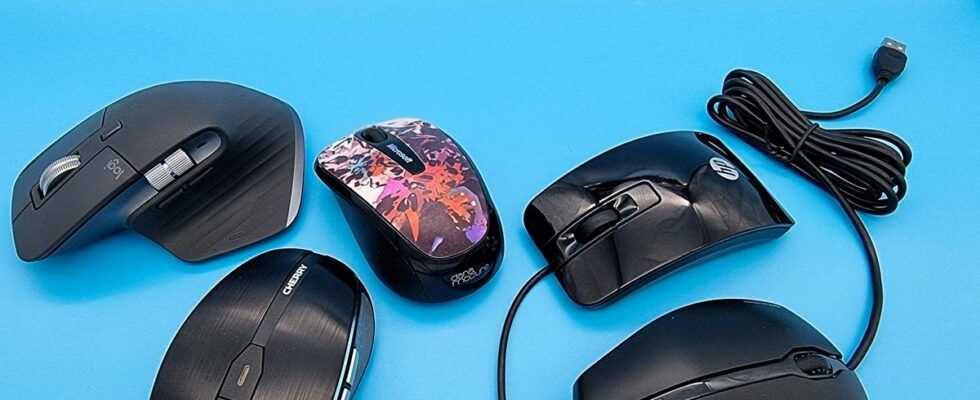The right mouse can make productive work much more pleasant. Of course, a cheap 0815 mouse is also sufficient for answering e-mails, editing tables or creating multimedia content. But a high-quality mouse is much more reliable and precise, and mostly also more convenient to use. In this article, we reveal which points you should consider when buying.
Those who do a lot of office work on the PC often neglect the advantages of a really good office mouse. We even find that many models make a big difference in everyday work. Especially if you use them many hours a day. Because ergonomic properties are also important here: The right shape ensures that the wrist and shoulders are less stressed. In addition, higher quality office mice use better sensors that scan more reliably and more accurately. In addition, the rodents can often be adjusted to their own preferences, for example with regard to the sampling rate or key assignments – this can make daily business easier, as this guide in our home office theme shows.
Ergonomics: Ergonomic mice for workaholics
If you use a PC mouse many hours a day, you should always use an ergonomically shaped model. They are designed so that they sit better in the hand and put less strain on the fingers, wrist and shoulders. Such devices often also offer additional buttons that have been integrated in such a way that they can be comfortably reached without having to change your hand.
Vertical mice are said to offer particularly high ergonomics. Due to the unusual shape of the housing, the mouse is guided in a neutral position by holding the hand at an angle of up to 90 degrees – similar to shaking hands. Compared to a conventional mouse, a vertical model significantly reduces muscle strain. Anyone who already suffers from symptoms such as carpal tunnel syndrome or RSI syndrome should switch to a vertical mouse as soon as possible, which can often alleviate such symptoms. However, the vertical posture requires a certain amount of time to get used to.
Ultimately, the actual degree of ergonomics also depends heavily on the respective user. Because everyone grabs their mouse a little differently and the length of the fingers is different. For example, some place their entire hand on the mouse, while others use the mouse only with their fingertips. This is why the size of the office mouse is an important factor when it comes to ergonomics and comfort. What we want to say: Ideally, you use the mouse you want extensively in everyday productive life to make a final purchase decision.
The volume of the clicking noise caused by pressing the mouse buttons is also often neglected. Even if the noise doesn’t get on your nerves personally, the constant clicking can disturb people in the immediate vicinity. Some manufacturers therefore offer variants that trigger particularly quietly.
Sampling rate and sensor
One of the most important information about a mouse is the sampling rate of the integrated sensor, which is specified in DPI or CPI. In very simplified terms, this value says how fast the mouse pointer moves across the screen. This value is particularly important for high-resolution screens or multi-monitor setups. Take, for example, a 4K display that has a resolution of 3,840 x 2,160 pixels. A mouse that works with a 400 DPI high sampling rate, you have to move about 25 centimeters in order to navigate the cursor from the left to the right corner. If the mouse works at 3,000 DPI, then it is only four centimeters for the same distance.
But fast is not always better. Because you can work really precisely with a rather low DPI, primarily with image editing programs. Ideally, the mouse can handle different DPI levels, between which you can switch quickly and easily.
Mice work either with a laser sensor or an optical one. In principle, these are different variants of the same technology. With optical sensors, an LED throws a light beam onto the surface, which is reflected from it, while a laser sensor uses the bundled light beam that gives it its name to scan the surface. The latter therefore also work on significantly more surfaces, such as glass. So if you want to use your mouse on the go or often change your place, you should use a mouse with a laser sensor. However, you are not much worse off with an optical sensor.
Wireless or wired mouse
Cordless mice are ideal for use on the move and allow more flexible handling, as there is no cable in the way. Until recently, however, the wireless mice had to be reproached for being slow to react, working imprecisely and quickly running out of juice. But now wireless mice are in almost no way inferior to their wired counterparts when it comes to use in the office.
Buyers have the choice between models that use a supplied USB dongle in the 2.4 GHz network, or that are capable of Bluetooth. The former technology may generally be quicker and easier to set up, as it does not require a coupling process – just plug the receiver into the PC and off you go. But Bluetooth is proving to be more convenient in everyday life. Many current notebooks, PCs and especially tablets support wireless technology without additional hardware. After pairing it once, the mouse can also be easily used on multiple devices. The battery life of wireless mice is no longer a problem.
Conclusion
So when you decide to buy a new office mouse, you will have a clear idea of what you will mainly use it for. For designers, a model with a precise laser sensor could be worthwhile, while users with high-resolution or multiple screens should use mice with high, adjustable DPI. But one thing remains: it’s best to try it out intensively!
